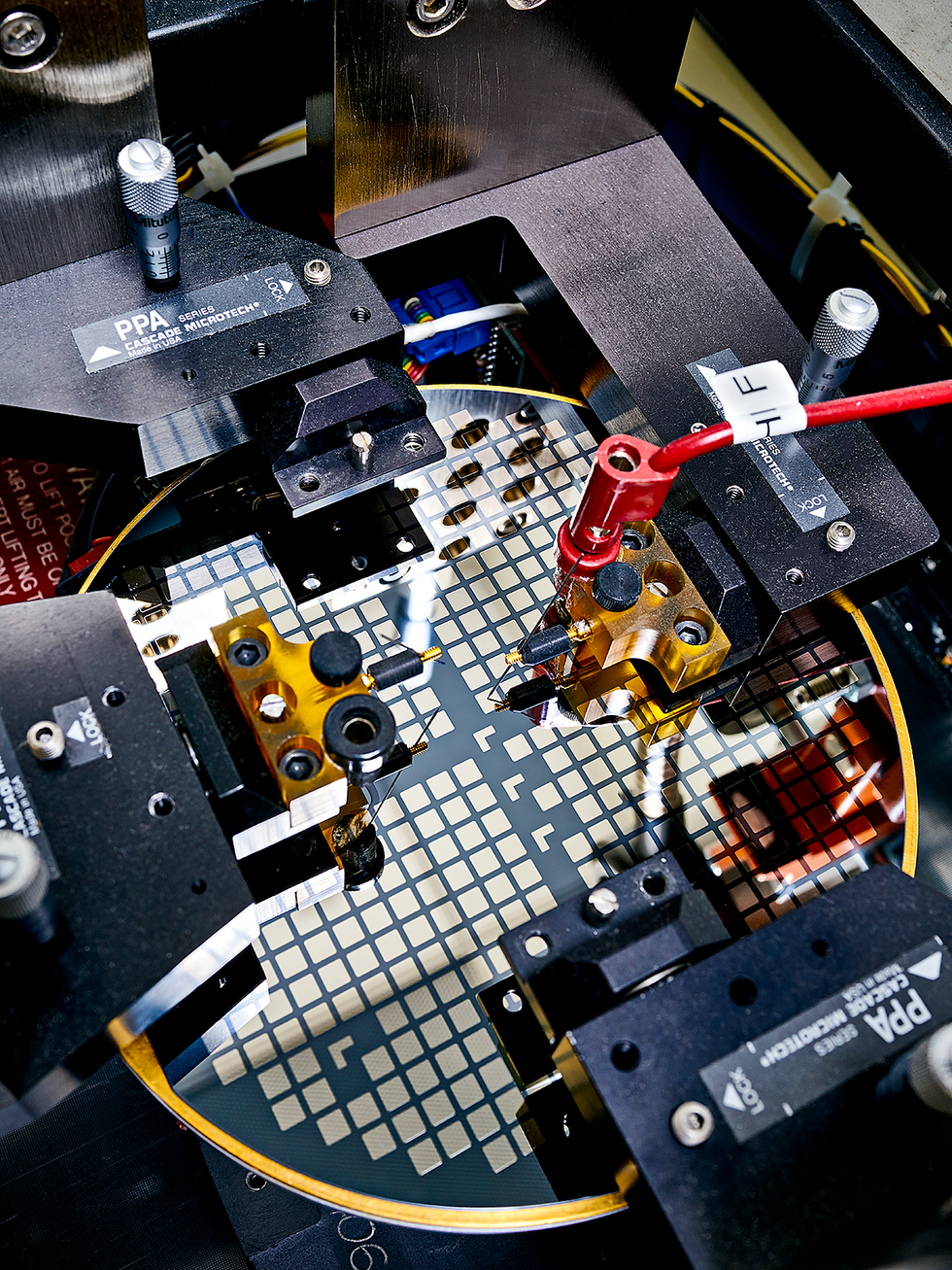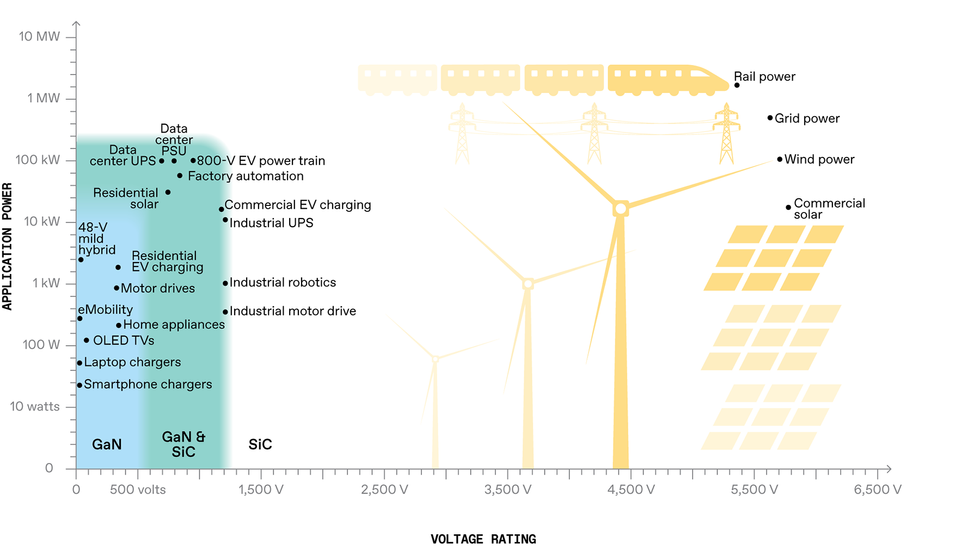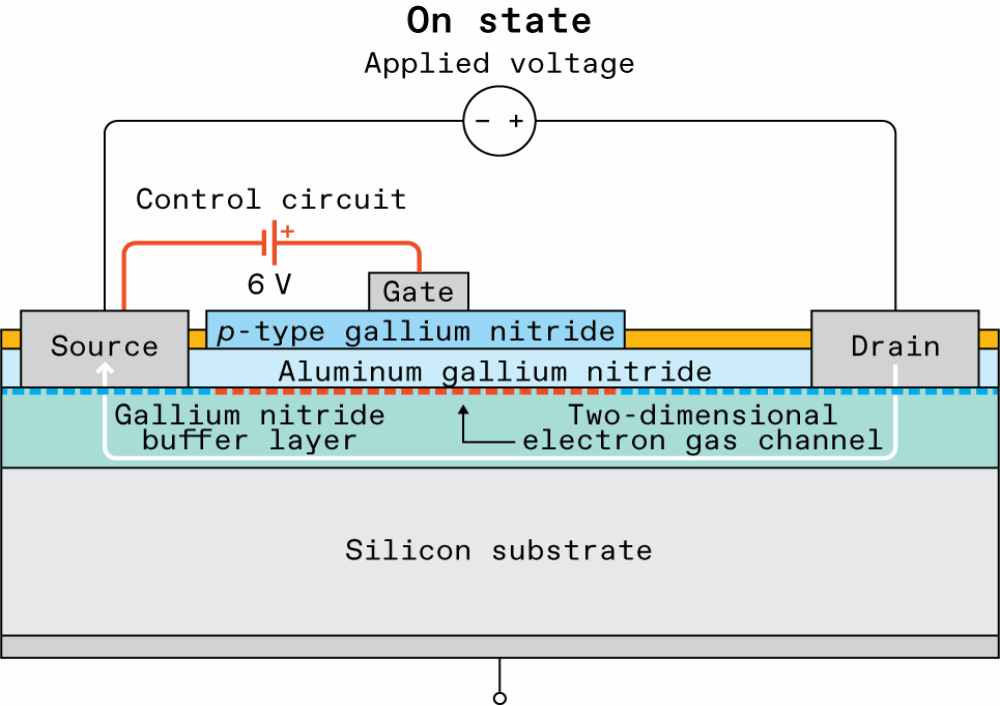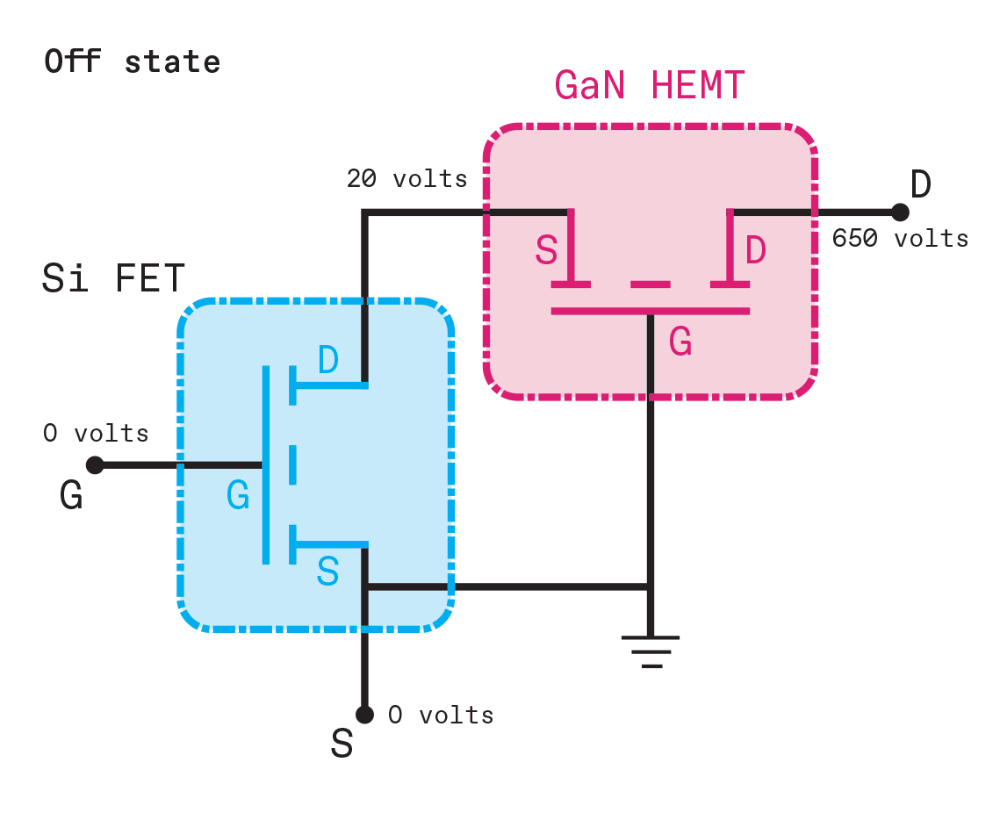
Can advanced semiconductors cut emissions of greenhouse gases enough to make a difference in the struggle to halt climate change? The answer is a resounding yes. Such a change is actually well underway.
Starting around 2001, the compound semiconductor gallium nitride fomented a revolution in lighting that has been, by some measures, the fastest technology shift in human history. In just two decades, the share of the global lighting market held by gallium-nitride-based light-emitting diodes has gone from zero to more than 50 percent, according to a study by the International Energy Agency. The research firm Mordor Intelligence recently predicted that, worldwide, LED lighting will be responsible for cutting the electricity used for lighting by 30 to 40 percent over the next seven years. Globally, lighting accounts for about 20 percent of electricity use and 6 percent of carbon dioxide emissions, according to the United Nations Environment Program.
 Each wafer contains hundreds of state-of-the-art power transistorsPeter Adams
Each wafer contains hundreds of state-of-the-art power transistorsPeter Adams
This revolution is nowhere near done. Indeed, it is about to jump to a higher level. The very semiconductor technology that has transformed the lighting industry, gallium nitride (GaN), is also part of a revolution in power electronics that is now gathering steam. It is one of two semiconductors—the other being silicon carbide (SiC)—that have begun displacing silicon-based electronics in enormous and vital categories of power electronics.
GaN and SiC devices perform better and are more efficient than the silicon components they are replacing. There are countless billions of these devices all over the world, and many of them operate for hours every day, so the energy savings are going to be substantial. The rise of GaN and SiC power electronics will ultimately have a greater positive impact on the planet’s climate than will the replacement of incandescent and other legacy lighting by GaN LEDs.
Virtually everywhere that alternating current must be transformed to direct current or vice versa, there will be fewer wasted watts. This conversion happens in your phone’s or laptop’s wall charger, in the much larger chargers and inverters that power electric vehicles, and elsewhere. And there will be similar savings as other silicon strongholds fall to the new semiconductors, too. Wireless base-station amplifiers are among the growing applications for which these emerging semiconductors are clearly superior. In the effort to mitigate climate change, eliminating waste in power consumption is the low-hanging fruit, and these semiconductors are the way we’ll harvest it.
This is a new instance of a familiar pattern in technology history: two competing innovations coming to fruition at the same time. How will it all shake out? In which applications will SiC dominate, and in which will GaN prevail? A hard look at the relative strengths of these two semiconductors gives us some solid clues.
Why Power Conversion Matters in Climate Calculations
Before we get to the semiconductors themselves, let’s first consider why we need them. To begin with: Power conversion is everywhere. And it goes far beyond the little wall chargers that sustain our smartphones, tablets, laptops, and countless other gadgets.
Power conversion is the process that changes electricity from the form that’s available to the form required for a product to perform its function. Some energy is always lost in that conversion, and because some of these products run continuously, the energy savings can be enormous. Consider: Electricity consumption in the state of California remained essentially flat from 1980 even as the economic output of the state skyrocketed. One of the most important reasons why the demand remained flat is that the efficiency of refrigerators and air conditioners increased enormously over that period. The single-greatest factor in this improvement has been the use of variable-speed drives based on the insulated gate bipolar transistor (IGBT) and other power electronics, which greatly increased efficiency.
SiC and GaN are going to enable far greater reductions in emissions. GaN-based technologies alone could lead to a savings of over 1 billion tonnes of greenhouse gases in 2041 in just the United States and India, according to an analysis of publicly available data by Transphorm, a GaN-device company I cofounded in 2007. The data came from the International Energy Agency, Statista, and other sources. The same analysis indicates a 1,400-terawatt-hour energy savings—or 10 to 15 percent of the projected energy consumption by the two countries that year.
Wide-Bandgap’s Advantages
Like an ordinary transistor, a power transistor can act as an amplifying device or as a switch. An important example of the amplifying role is in wireless base stations, which amplify signals for transmission to smartphones. All over the world, the semiconductor used to fabricate the transistors in these amplifiers is shifting from a silicon technology called laterally diffused metal-oxide semiconductor (LDMOS) to GaN. The newer technology has many advantages, including a power-efficiency improvement of 10 percent or more depending on frequencies. In power-conversion applications, on the other hand, the transistor acts as a switch rather than as an amplifier. The standard technique is called pulse-width modulation. In a common type of motor controller, for example, pulses of direct-current electricity are fed to coils mounted on the motor’s rotor. These pulses set up a magnetic field that interacts with that of the motor’s stator, which makes the rotor spin. The speed of this rotation is controlled by altering the length of the pulses: A graph of these pulses is a square wave, and the longer the pulses are “on” rather than “off,” the more rotational speed and torque the motor provides. Power transistors accomplish the on-and-off switching.
Pulse-width modulation is also used in switching power supplies, one of the most common examples of power conversion. Switching power supplies are the type used to power virtually all personal computers, mobile devices, and appliances that run on DC. Basically, the input AC voltage is converted to DC, and then that DC is “chopped” into a high-frequency alternating-current square wave. This chopping is done by power transistors, which create the square wave by switching the DC on and off. The square wave is applied to a transformer that changes the amplitude of the wave to produce the desired output voltage. To get a steady DC output, the voltage from the transformer is rectified and filtered.
The important point here is that the characteristics of the power transistors determine, almost entirely, how well the circuits can perform pulse-width modulation—and therefore, how efficiently the controller regulates the voltage. An ideal power transistor would, when in the off state, completely block current flow even when the applied voltage is high. This characteristic is called high electric breakdown field strength, and it indicates how much voltage the semiconductor is able to withstand. On the other hand, when it is in the on state, this ideal transistor would have very low resistance to the flow of current. This feature results from very high mobility of the charges—electrons and holes—within the semiconductor’s crystalline lattice. Think of breakdown field strength and charge mobility as the yin and yang of a power semiconductor.
GaN transistors are very unusual because most of the current flowing through them is due to electron velocity rather than electron charge.
GaN and SiC come much closer to this ideal than the silicon semiconductors they are replacing. First, consider breakdown field strength. Both GaN and SiC belong to a class called wide-bandgap semiconductors. The bandgap of a semiconductor is defined as the energy, in electron volts, needed for an electron in the semiconductor lattice to jump from the valence band to the conduction band. An electron in the valence band participates in the bonding of atoms within the crystal lattice, whereas in the conduction band electrons are free to move around in the lattice and conduct electricity.
In a semiconductor with a wide bandgap, the bonds between atoms are strong and so the material is usually able to withstand relatively high voltages before the bonds break and the transistor is said to break down. The bandgap of silicon is 1.12 electron volts, as compared with 3.40 eV for GaN. For the most common type of SiC, the band gap is 3.26 eV. [See table below, “The Wide-Bandgap Menagerie”]
Now let’s look at mobility, which is given in units of centimeters squared per volt second (cm2/V·s). The product of mobility and electric field yields the velocity of the electron, and the higher the velocity the higher the current carried for a given amount of moving charge. For silicon this figure is 1,450; for SiC it is around 950; and for GaN, about 2,000. GaN’s unusually high value is the reason why it can be used not only in power-conversion applications but also in microwave amplifiers. GaN transistors can amplify signals with frequencies as high as 100 gigahertz—far above the 3 to 4 GHz generally regarded as the maximum for silicon LDMOS. For reference, 5G’s millimeter-wave frequencies top out at 52.6 GHz. This highest 5G band is not yet widely used, however, frequencies up to 75 GHz are being deployed in dish-to-dish communications, and researchers are now working with frequencies as high as 140 GHz for in-room communications. The appetite for bandwidth is insatiable.
These performance figures are important, but they’re not the only criteria by which GaN and SiC should be compared for any particular application. Other critical factors include ease of use and cost, for both the devices and the systems into which they are integrated. Taken together, these factors explain where and why each of these semiconductors has begun displacing silicon—and how their future competition may shake out.
SiC Leads GaN in Power Conversion Today…
The first commercially viable SiC transistor that was superior to silicon was introduced by Cree (now Wolfspeed) in 2011. It could block 1,200 volts and had a respectably low resistance of 80 milliohms when conducting current. Today there are three different kinds of SiC transistors on the market. There’s a trench MOSFET (metal-oxide semiconductor field-effect transistor) from Rohm; DMOSs (double-diffused MOSs) from Infineon Technologies, ON Semiconductor Corp., STMicroelectronics, Wolfspeed, and others; and a vertical-junction field-effect transistor from Qorvo.
One of the big advantages of SiC MOSFETs is their similarity to traditional silicon ones—even the packaging is identical. A SiC MOSFET operates in essentially the same way as an ordinary silicon MOSFET. There’s a source, a gate, and a drain. When the device is on, electrons flow from a heavily doped n-type source across a lightly doped bulk region before being “drained” through a conductive substrate. This similarity means that there’s little learning curve for engineers making the switch to SiC.
Compared to GaN, SiC has other advantages. SiC MOSFETs are inherently “fail-open” devices, meaning that if the control circuit fails for any reason the transistor stops conducting current. This is an important feature, because this characteristic largely eliminates the possibility that a failure could lead to a short circuit and a fire or explosion. (The price paid for this feature, however, is a lower electron mobility, which increases resistance when the device is on.)
…But GaN Is Gaining
GaN brings its own unique advantages. The semiconductor first established itself commercially in 2000 in the markets for light-emitting diodes and semiconductor lasers. It was the first semiconductor capable of reliably emitting bright green, blue, purple, and ultraviolet light. But long before this commercial breakthrough in optoelectronics, I and other researchers had already demonstrated the promise of GaN for high-power electronics. GaN LEDs caught on quickly because they filled a void for efficient lighting. But GaN for electronics had to prove itself superior to existing technologies: in particular, silicon CoolMOS transistors from Infineon for power electronics, and silicon-LDMOS and gallium-arsenide transistors for radio-frequency electronics.
GaN’s main advantage is its extremely high electron mobility. Electric current, the flow of charge, equals the concentration of the charges multiplied by their velocity. So you can get high current because of high concentration or high velocity or some combination of the two. The GaN transistor is unusual because most of the current flowing through the device is due to electron velocity rather than charge concentration. What this means in practice is that, in comparison with Si or SiC, less charge has to flow into the device to switch it on or off. That, in turn, reduces the energy needed for each switching cycle and contributes to high efficiency.
Meanwhile, GaN’s high electron mobility allows switching speeds on the order of 50 volts per nanosecond. That characteristic means power converters based on GaN transistors operate efficiently at frequencies in the multiple hundreds of kilohertz, as opposed to about 100 kilohertz for silicon or SiC.
Taken together, the high efficiency and high frequency enables the power converter based on GaN devices to be quite small and lightweight: High efficiency means smaller heat sinks, and operation at high frequencies means that the inductors and capacitors can be very small, too.
One disadvantage of GaN semiconductors is that they do not yet have a reliable insulator technology. This complicates the design of devices that are fail-safe—in other words, that fail open if the control circuit fails.
There are two options to achieve this normally off characteristic. One is to equip the transistor with a type of gate that removes the charge in the channel when there’s no voltage applied to the gate and that conducts current only on application of a positive voltage to that gate. These are called enhancement-mode devices. They are offered by EPC, GaN Systems, Infineon,Innoscience, and Navitas, for example. [See illustration, "Enhancement-Mode GaN Transistor"]
The other option is called the cascode solution. It uses a separate, low-loss silicon field-effect transistor to provide the fail-safe feature for the GaN transistor. This cascode solution is used by Power Integrations, Texas Instruments, and Transphorm. [See illustration, "Cascoded Depletion-Mode GaN Transistor"]
No comparison of semiconductors is complete without a consideration of costs. A rough rule of thumb is—smaller die size means lower cost. Die size is the physical area of the integrated circuit containing the devices.
SiC devices now generally have smaller dies than GaN ones. However, SiC’s substrate and fabrication costs are higher than those for GaN and, in general, the final device costs for applications at 5 kilowatts and higher are not much different today. Future trends, though, are likely to favor GaN. I base this belief on the relative simplicity of GaN devices, which will mean production costs low enough to overcome the larger die size.
That said, for GaN to be viable for many high-power applications that also demand high voltages, it must have a cost-effective, high-performance device rated for 1,200 V. After all, there are already SiC transistors available at that voltage. Currently, the closest commercially available GaN transistors are rated for 900 V, produced by Transphorm, which I cofounded with Primit Parikh. Lately, we have also demonstrated 1,200-V devices, fabricated on sapphire substrates, that have both electrical and thermal performance on a par with SiC devices.
Projections from the research firm Omdia for 1,200-V SiC MOSFETs indicate a price of 16 cents per ampere in 2025. In my estimation, because of the lower cost of GaN substrates, the price of first-generation 1,200-V GaN transistors in 2025 will be less than that of their SiC counterparts. Of course, that’s just my opinion; we’ll all know for sure how this will shake out in a couple of years.
GaN vs. SiC: Handicapping the Contests
With these relative advantages and disadvantages in mind, let’s consider individual applications, one by one, and shed some light on how things might develop.
• Electric vehicle inverters and converters: Tesla’s adoption of SiC in 2017 for the onboard, or traction, inverters for its Model 3 was an early and major win for the semiconductor. In an EV, the traction inverter converts the DC from the batteries to AC for the motor. The inverter also controls the speed of the motor by varying the frequency of the alternating current. Today, Mercedes-Benz and Lucid Motors are also using SiC in their inverters and other EV makers are planning to use SiC in upcoming models, according to news reports. The SiC devices are being supplied by Infineon, OnSemi, Rohm, Wolfspeed, and others. EV traction inverters typically range from about 35 kW to 100 kW for a small EV to about 400 kW for a large vehicle.
However, it’s too soon to call this contest for SiC. As I noted, to make inroads in this market, GaN suppliers will have to offer a 1,200-V device. EV electrical systems now typically operate at just 400 volts, but the Porsche Taycan has an 800-V system, as do EVs from Audi, Hyundai, and Kia. Other automakers are expected to follow their lead in coming years. (The Lucid Air has a 900-V system.) I expect to see the first commercial 1,200-V GaN transistors in 2025. These devices will be used not only in vehicles but also in high-speed public EV chargers.
The higher switching speeds possible with GaN will be a powerful advantage in EV inverters, because these switches employ what are called hard-switched techniques. Here, the way to enhance performance is to switch very fast from on to off to minimize the time when the device is both holding high voltage and passing high current.
Besides an inverter, an EV also typically has an onboard charger, which enables the vehicle to be charged from wall (mains) current by converting AC to DC. Here, again, GaN is very attractive, for the same reasons that make it a good choice for inverters.
• Electric-grid applications: Very-high-voltage power conversion for devices rated at 3 kV and higher will remain the domain of SiC for at least the next decade. These applications include systems to help stabilize the grid, convert AC to DC and back again at transmission-level voltages, and other uses.
• Phone, tablet, and laptop chargers: Starting in 2019, GaN-based wall chargers became available commercially from companies such as GaN Systems, Innoscience, Navitas, Power Integrations, and Transphorm. The high switching speeds of GaN coupled with its generally lower costs have made it the incumbent in lower-power markets (25 to 500 W), where these factors, along with small size and a robust supply chain, are paramount. These early GaN power converters had switching frequencies as high as 300 kHz and efficiencies above 92 percent. They set records for power density, with figures as high as 30 W per cubic inch (1.83 W/cm3)—roughly double the density of the silicon-based chargers they are replacing.
 An automated system of probes applies a high voltage to stress test power transistors on a wafer. The automated system, at Transphorm, tests each one of some 500 die in minutes. Peter Adams
An automated system of probes applies a high voltage to stress test power transistors on a wafer. The automated system, at Transphorm, tests each one of some 500 die in minutes. Peter Adams
• Solar-power microinverters: Solar-power generation has taken off in recent years, in both grid-scale and distributed (household) applications. For every installation, an inverter is needed to convert the DC from the solar panels to AC to power a home or release the electricity to the grid. Today, grid-scale photovoltaic inverters are the domain of silicon IGBTs and SiC MOSFETs. But GaN will begin making inroads in the distributed solar market, particularly.
Traditionally, in these distributed installations, there was a single inverter box for all of the solar panels. But increasingly installers are favoring systems in which there is a separate microinverter for each panel, and the AC is combined before powering the house or feeding the grid. Such a setup means the system can monitor the operation of each panel in order to optimize the performance of the whole array.
Microinverter or traditional inverter systems are critical to the modern data center. Coupled with batteries they create an uninterruptible power supply to prevent outages. Also, all data centers use power-factor correction circuits, which adjust the power supply’s alternating-current waveforms to improve efficiency and remove characteristics that could damage equipment. And for these, GaN provides a low-loss and economical solution that is slowly displacing silicon.
• 5G and 6G base stations: GaN’s superior speed and high power density will enable it to win and ultimately dominate applications in the microwave regimes, notably 5G and 6G wireless, and commercial and military radar. The main competition here are arrays of silicon LDMOS devices, which are cheaper but have lower performance. Indeed, GaN has no real competitor at frequencies of 4 GHz and above.
For 5G and 6G wireless, the critical parameter is bandwidth, because it determines how much information the hardware can transmit efficiently. Next-generation 5G systems will have nearly 1 GHz of bandwidth, enabling blazingly fast video and other applications.
Microwave-communication systems that use silicon-on-insulator technologies provide a 5G+ solution using high-frequency silicon devices where each device’s low output power is overcome with large arrays of them. GaN and silicon will coexist for a while in this space. The winner in a specific application will be determined by a trade-off among system architecture, cost, and performance.
• Radar: The U.S. military is deploying many ground-based radar systems based on GaN electronics. These include the Ground/Air Task Oriented Radar and the Active Electronically Scanned Array Radar built by Northrup-Grumman for the U.S. Marine Corps. Raytheon’s SPY6 radar was delivered to the U.S. Navy and tested for the first time at sea in December 2022. The system greatly extends the range and sensitivity of shipborne radar.
The Wide-Bandgap Battle Is Just Beginning
Today, SiC dominates in EV inverters, and generally wherever voltage-blocking capability and power handling are paramount and where the frequency is low. GaN is the preferred technology where high-frequency performance matters, such as in base stations for 5G and 6G, and for radar and high-frequency power-conversion applications such as wall-plug adapters, microinverters, and power supplies.
But the tug-of-war between GaN and SiC is just beginning. Regardless of how the competition plays out, application by application and market by market, we can say for sure that the Earth’s environment will be a winner. Countless billions of tonnes of greenhouse gases will be avoided in coming years as this new cycle of technological replacement and rejuvenation wends its way inexorably forward.
Reference: https://ift.tt/TgmSP4E












 Lightning Motorcycles claims that the Lightning Strike motorcycle can fill its battery from 20 percent to 80 percent in a little over 10 minutes on a Level 3 DC fast charger. Lightning Motorcycles
Lightning Motorcycles claims that the Lightning Strike motorcycle can fill its battery from 20 percent to 80 percent in a little over 10 minutes on a Level 3 DC fast charger. Lightning Motorcycles
















 Author, Nita FarahanyMerritt Chesson
Author, Nita FarahanyMerritt Chesson




 Sateliot
Sateliot Open Cosmos
Open Cosmos



 Each wafer contains hundreds of state-of-the-art power transistorsPeter Adams
Each wafer contains hundreds of state-of-the-art power transistorsPeter Adams In the markets for high-voltage power transistors, gallium nitride devices dominate in applications below around 400 volts, while silicon carbide has the edge now for 800 V and above (the markets are relatively small above around 2,000 V). The landscape of the important battleground between 400 and 1,000 V will change as GaN devices improve. For example, with the introduction of 1,200-V GaN transistors—expected in 2025—the battle will be joined in the all-important market for electric-vehicle inverters.Chris Philpot
In the markets for high-voltage power transistors, gallium nitride devices dominate in applications below around 400 volts, while silicon carbide has the edge now for 800 V and above (the markets are relatively small above around 2,000 V). The landscape of the important battleground between 400 and 1,000 V will change as GaN devices improve. For example, with the introduction of 1,200-V GaN transistors—expected in 2025—the battle will be joined in the all-important market for electric-vehicle inverters.Chris Philpot One of the two major types of gallium nitride transistor is called an enhancement-mode device. It uses a gate-control circuit operating at around 6 volts to control the main switching circuit, which can block 600 V or more when the control circuit is off. When the device is on (when 6 V are applied to the gate), electrons flow from the drain to the source in a flat region called a two-dimensional electron gas. In this region the electrons are extremely mobile—a factor that helps enable very high switching speeds—and confined beneath a barrier of aluminum gallium nitride. When the device is off, the region below the gate is depleted of electrons, breaking the circuit under the gate and stopping current flow.Chris Philpot
One of the two major types of gallium nitride transistor is called an enhancement-mode device. It uses a gate-control circuit operating at around 6 volts to control the main switching circuit, which can block 600 V or more when the control circuit is off. When the device is on (when 6 V are applied to the gate), electrons flow from the drain to the source in a flat region called a two-dimensional electron gas. In this region the electrons are extremely mobile—a factor that helps enable very high switching speeds—and confined beneath a barrier of aluminum gallium nitride. When the device is off, the region below the gate is depleted of electrons, breaking the circuit under the gate and stopping current flow.Chris Philpot For safety, when a power transistor’s control circuit fails, it must fail into the open state, with no current flow. This is a challenge for gallium nitride devices because they lack a gate-insulator material that is reliable both in the high-voltage blocking state and in the current-carrying on state. One solution, called cascoded depletion-mode, uses a low-voltage signal on a silicon field-effect transistor (FET) to control the much larger voltage on a gallium nitride high electron mobility transistor [above right]. If the control circuit fails, the voltage on the gate of the FET drops to zero and it stops conducting current [above left]. With the FET no longer conducting current, the gallium nitride transistor also stops conducting, because there is no longer a closed circuit between the drain and the source of the combined device. Chris Philpot
For safety, when a power transistor’s control circuit fails, it must fail into the open state, with no current flow. This is a challenge for gallium nitride devices because they lack a gate-insulator material that is reliable both in the high-voltage blocking state and in the current-carrying on state. One solution, called cascoded depletion-mode, uses a low-voltage signal on a silicon field-effect transistor (FET) to control the much larger voltage on a gallium nitride high electron mobility transistor [above right]. If the control circuit fails, the voltage on the gate of the FET drops to zero and it stops conducting current [above left]. With the FET no longer conducting current, the gallium nitride transistor also stops conducting, because there is no longer a closed circuit between the drain and the source of the combined device. Chris Philpot